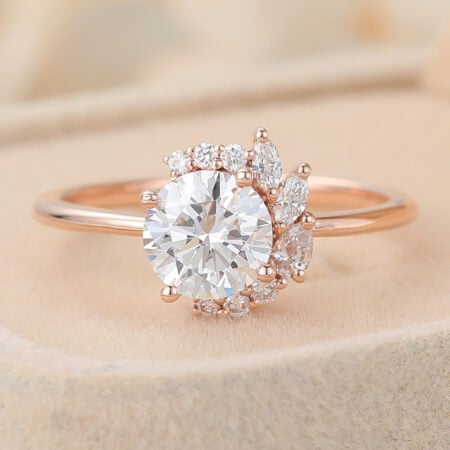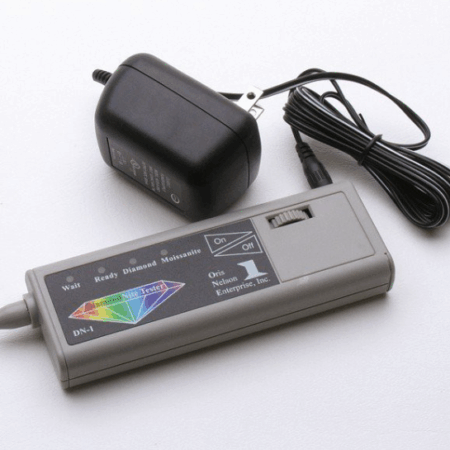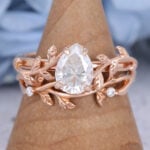How to Tell if a Diamond Is Real: 15 Ways From Easy Home Tests to High-Tech Equipment
When purchasing a diamond ring or inheriting diamond jewelry, knowing how to tell if a diamond is real becomes crucial. With so many imitations on the market, from glass to cubic zirconia, it’s easy to be misled without the right knowledge. This guide walks you through both at-home methods and specialized equipment to help you verify your diamond with confidence.
What are Considered Real Diamonds?
To understand how to tell if a diamond is real, you first need to know what qualifies as a real diamond. Simply put, natural diamonds (original diamond) are real diamonds. In addition, lab-grown diamonds—also known as man-made, lab-created, or synthetic diamonds—are also considered real. Natural diamonds form over billions of years under intense heat and pressure within the Earth, resulting in unique inclusions and growth patterns. They are regarded as the most authentic form of diamond. Lab-grown diamonds are created in laboratories that replicate these natural conditions, and they share the same chemical composition, appearance, and physical properties as natural diamonds. In essence, real diamonds must be composed of carbon and possess a true diamond crystal structure.

What are Considered Fake Diamonds?
A ‘Fake Diamond’ refers to a material that resembles a diamond in appearance but lacks the true characteristics of a real diamond in terms of composition, structure, or physical properties. These diamond simulants may mimic the brilliance or hardness of a diamond, but they are not considered genuine diamonds because they are not made of pure carbon and do not have a diamond crystal structure. Moissanite is regarded as one of the best fake diamonds, offering more fire than a diamond, but it is composed of silicon carbide, not carbon. Cubic Zirconia (CZ) is another common diamond simulant—it has a bright appearance but is softer, more prone to wear, and much less expensive. In addition, some diamond simulants made from glass or crystal may look similar to real diamonds, but they lack the hardness, refractive index, and carbon composition of a real diamond, and thus are not classified as genuine diamonds.
Also Read: Cubic Zirconia vs Moissanite–Which Diamond Alternatives to Choose?
What Is a Simulated Diamond? Meaning, Differences, and How to Tell It Apart
What’s the Difference between Real Diamond and Fake Diamond?
Understanding the difference between real and fake diamonds starts with their composition. A real diamond is made of pure carbon atoms arranged in a tight crystal structure, giving it unmatched hardness, brilliance, and thermal conductivity. In contrast, kinds of fake diamonds—such as cubic zirconia, moissanite, and glass—are composed of entirely different materials. These simulants may sparkle, but they lack the durability, density, and light behavior of a true diamond. Many types of fake jewelry that looks real can fool the untrained eye, but under magnification or testing, their flaws become clear. When comparing real diamond vs fake diamond, the differences lie not just in appearance but in physical traits like hardness, refractive index, and heat conductivity. Understanding these core distinctions is essential before exploring testing methods that reveal whether a stone is genuine.
How to Tell if a Diamond Is Real at Home (How to Tell A Real Diamond By Eye)
1. Fog Test
To do the fog test on a diamond, breathe on the stone to fog it up. A genuine diamond clears almost instantly due to high heat conductivity. In comparison, fakes like glass fog up longer. This simple diamond testing method offers a quick way to compare real vs fake diamonds, though it’s best used with other checks.
2. Water Test
To do the diamond water test, fill a glass with water and gently drop the loose stone in. A real diamond has high density, so it sinks quickly. If it floats or sinks slowly, it may be fake. You can test a diamond with water at home as a simple fake diamond test, but pair it with other methods for accuracy.
3. Scratch Test
One way to identify if a diamond is real is the scratch test. Use the stone to gently scratch a piece of glass. A real diamond, with a Mohs hardness of 10, can easily leave a mark, proving its toughness. If it doesn’t scratch, it’s likely fake. While helpful, this method may damage softer materials, so use caution when checking diamond authenticity.
4. Read-Through Test (Newspaper Test)
To perform this test of diamond, place the stone flat-side down on a newspaper or printed text. If you can clearly read the letters through the stone, it’s likely not a real diamond. Genuine diamonds refract light strongly, making the text beneath unreadable. This is an easy way to spot a fake diamond using its optical properties.
5. Magnification Test (Using a Loupe)
Use a jeweler’s loupe or magnifying glass to examine the stone closely. A real diamond typically shows small flaws or inclusions—known as imperfections in a diamond—which occur naturally during formation. In contrast, fake diamonds like cubic zirconia often appear too perfect, with no internal marks. This test helps distinguish natural from synthetic stones based on visible characteristics.
6. Heat and Cold Shock Test (Thermal Shock)
To tell a real diamond from a fake one, you can perform a simple heat and cold shock test. First, heat the stone with a lighter for about 30–40 seconds, then immediately drop it into a glass of cold water. A real diamond will remain intact due to its excellent thermal conductivity and internal structure. In contrast, a fake diamond—especially those made of glass or cubic zirconia—may crack or shatter from the sudden temperature change. This test works because real diamonds can withstand extreme temperature shifts without damage.
7.Diamond Dot Test
The Diamond Dot Test is a simple diamond test that helps identify genuine diamonds. Place the stone flat-side down on a piece of white paper and look through the pointed end. If you see a small black dot in diamond, it indicates the stone is real, as this dot is caused by light reflecting inside the diamond’s facets. Fake diamonds often don’t produce this effect, appearing clear or distorted instead. This quick visual check is a handy tool among basic diamond tests.
8.UV Light Test (Black Light Diamond Test)
The UV light test, also known as the black light diamond test, is a useful diamond identifier method. To perform it, place the diamond under an ultraviolet (UV) light in a dark room. Many real diamonds will emit a blue fluorescence glow, helping distinguish them from some fakes that show little or no glow. However, not all genuine diamonds fluoresce, so this test alone isn’t conclusive but can be a helpful part of multiple diamond testing methods.
How to Tell if a Diamond Is Real Using Professional Tools
1. Diamond Tester
A diamond tester is a handheld device that detects thermal or electrical conductivity. To use it, turn the tester on, let it calibrate, then press the metal tip against the stone. Real diamonds conduct heat or electricity much better than fakes like cubic zirconia. If the tester shows a strong signal or beeps for diamond, it confirms diamond authenticity. This tool is widely used by jewelers as a fast, reliable way to tell if a diamond is real.
Also Read: Does Moissanite Pass Diamond Tester?

2. Multi-Tester
A multi-tester is an advanced tool that measures both thermal and electrical conductivity, making it one of the most reliable instruments to tell a diamond from a moissanite. To use it, power on the device and allow it to calibrate. Then gently place the probe tip on the surface of the stone. If both conductivity readings match those of a diamond, the tester will confirm its authenticity. By combining two testing principles, a multi-tester helps reduce false positives and offers a highly accurate way to tell if a diamond is real.
3. Polariscope Analysis
A polariscope is a tool used in gemology to detect optical properties such as birefringence. To perform the test, place the diamond between two polarized lenses and slowly rotate it under light. A real diamond reflection will remain unchanged or dark due to its single-refractive nature. In contrast, synthetic stones or simulants like cubic zirconia show changing light patterns, indicating double refraction. This is a reliable method for how to tell if a diamond is real, as natural diamonds are optically isotropic, helping distinguish them from most fakes.
4. Spectroscope Test
A spectroscope separates light into its spectral components to detect the absorption lines specific to different gemstones. To conduct this test, direct a concentrated light source through the diamond and into the spectroscope. Observe the resulting spectrum through the eyepiece. A real diamond often shows little to no absorption, or faint bands in the blue and yellow regions, depending on trace elements like nitrogen. Synthetic or fake stones tend to display more distinct and different absorption lines. This test leverages the diamond’s atomic structure and light interaction, making it an effective method for identifying authenticity through unique spectral fingerprints.
5. Microscopic Evaluation
A microscopic evaluation is a professional method used to examine a diamond’s internal characteristics. Using a jeweler’s loupe or a microscope (typically 10x magnification or higher), gemologists inspect the stone for natural inclusions such as feathering, mineral crystals, or needle-like imperfections. These imperfections in a diamond are signs of authenticity, as synthetic or fake stones often appear flawless. Professionals can also check for polishing marks or laser inscriptions on real diamonds. This method helps determine if a diamond is lab-created or natural and is a reliable part of the authentication process.
6.X-ray Examination
X-ray examination is a highly accurate method used to distinguish real diamonds from simulants like cubic zirconia. Diamonds have a unique atomic structure composed of carbon atoms arranged in a specific crystal lattice, which makes them radiolucent—they do not absorb X-rays the same way most fakes do. During this test, the stone is exposed to X-rays, and its absorption or transmission pattern is analyzed. Real diamonds allow more X-rays to pass through, whereas simulants appear opaque. This non-destructive test is often performed in gemological labs as a definitive way to verify diamond authenticity.
7.Certified Gemological Reports
Certified gemological reports are official documents issued by accredited gemological laboratories like GIA, IGI, or AGS. These reports provide a comprehensive analysis of a diamond’s characteristics, including the 4Cs (cut, color, clarity, and carat weight), along with tests verifying its authenticity. To obtain the report, the diamond is submitted to a lab where trained gemologists use advanced tools—like spectroscopes, microscopes, and X-ray machines—to evaluate its properties. The resulting certificate serves as scientific proof of whether the stone is a real diamond and helps distinguish it from imitations or treated stones.
Also Read: IGI vs GIA: Which Diamond Certification Should You Trust?
Comparing Diamonds to Common Simulants
Diamond vs. Moissanite
Moissanite closely resembles a diamond but has different optical and physical properties. It shows more rainbow-colored flashes due to higher dispersion and double refraction. To tell a diamond from a moissanite, use a multi-tester or microscope to detect these differences. Moissanite is also slightly less hard than a real diamond, scoring 9.25 on the Mohs scale compared to a diamond’s 10.
Also Read: Moissanite vs Lab-Grown Diamond – A Comparison of Origin, Price, Appearance and Durability
Diamond vs. Cubic Zirconia
Cubic Zirconia (CZ) is a popular diamond simulant known for its affordability and brilliance. However, CZ is softer (around 8–8.5 Mohs hardness) and less dense than a real diamond. It also lacks the unique sparkle and thermal conductivity of diamonds, making it easier to identify with simple tests or professional tools.
Diamond vs. White Sapphire or Glass
White sapphires and glass are sometimes used as diamond substitutes due to their clear appearance. However, they have lower hardness and different optical properties than diamonds. Glass is much softer and scratches easily, while white sapphires lack the brilliance and fire of diamonds. These differences make it easier to distinguish them from real diamonds using basic tests or professional equipment.
Conclusion
Knowing how to tell if a diamond is real is essential for anyone buying or valuing diamonds. By understanding the key differences between real and fake diamonds, including their physical and optical properties, you can make informed decisions and avoid costly mistakes.
FAQs About How to Tell if a Diamond Is Real
A diamond is a natural carbon crystal known for its hardness and brilliance. Lab-grown diamonds are real diamonds with the same physical and chemical properties as mined ones.
Under magnification, diamonds show sharp facets and natural inclusions, while cubic zirconia appears flawless with rounded facet edges. A good comparison is cubic zirconia vs diamond under microscope.
Yes, because only a diamond is hard enough to cut another diamond, using specialized cutting tools tipped with diamond material.
Moissanite is considered the best diamond simulant due to its hardness and brilliance, though its sparkle differs from that of a diamond.
You can perform a real diamond testing by checking if it scratches glass, fogs up, or sinks in water. These home methods offer initial clues but aren’t always conclusive.
A real diamond has sharp edges, clear brilliance, and unique inclusions. Fake diamonds often appear too flawless or glassy. The real diamond sparkle vs fake is typically sharper and more refractive in genuine stones.
Some fake diamonds may glow brightly or unevenly under UV light, while real diamonds may fluoresce faintly or not at all.
Advanced gemological tools can identify lab-grown diamonds by detecting growth patterns and metallic inclusions. A diamond tester online cannot distinguish this; a certified lab report is best.
Many real diamonds are laser-inscribed with a microscopic serial number on the girdle, usually linked to their grading report.
Yes, a genuine diamond is a real one. White diamonds are also real diamonds—they are simply colorless or near-colorless.
Real diamonds can cut or scratch glass due to their superior hardness. Some fakes like moissanite or quartz can also scratch glass, so this test alone isn’t definitive.
Real diamonds sink in water due to their density. If the stone floats, it’s not a diamond—this is a simple method in diamond ring evaluation.
Real diamonds reflect both white and colored light but not in a flashy rainbow pattern. Overly colorful sparkle might indicate a fake.
Prices for diamond testers vary, but a basic device ranges from $15 to $100, depending on accuracy and features.
No, moissanite is a different gemstone. Though it looks similar, it is not a real diamond.
An original diamond has natural inclusions and growth patterns. The main difference between lab grown diamonds and real diamonds lies in origin; otherwise, they are chemically and physically the same.


